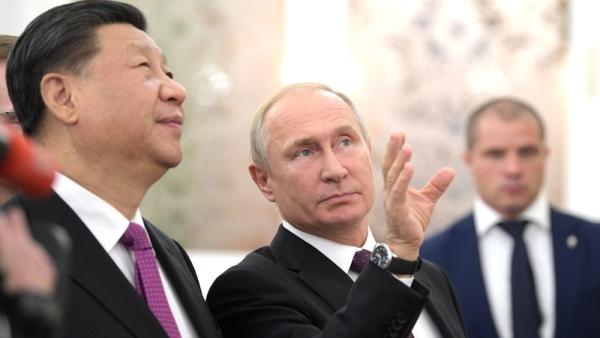The Presidential Press and Information Office / Wikimedia Commons

James Laurenceson, Director, Australia-China Relations Institute, University of Technology Sydney |
This article appeared in the Asia & the Pacific Policy Society at the Australian National University’s blog, Policy Forum, on March 7 2022.
Prominent current and former national security bureaucrats took to the airwaves last month to describe the Australian government’s tactic of accusing the federal opposition of being ‘in bed’ with China as, amongst other things, ‘grubby beyond belief’.
The latest step in the government’s ramping up of the ‘China threat’ narrative appears to be in elevating talk of an ‘arc of autocracies’ and a ‘growing demarcation between authoritarian and liberal states’, referring primarily to the China-Russia relationship.
Some members of Australia’s commentariat who are attracted to a binary description of Australia and its place in the world have predictably amplified the message.
Prime Minister Scott Morrison contends that he’s been warning about ‘this’ for years. He hasn’t, but what’s unfolding now is what’s most important.
Then, a fortnight ago, the prime minister told Australians that China had been ‘chillingly silent’ when it came to Russian troops massing near the Ukrainian border. ABC foreign affairs reporter, Stephen Dzeidzic, drew out the obvious insinuation that China had given Russia some kind of ‘tacit approval’ of an invasion.
A day after the Russian invasion began, Morrison tagged China as an enabler. This was apparently because China had announced it would open its market to Russian wheat.
On the same day, Defence Minister Peter Dutton claimed the ‘the world has been united in its view against President Putin going into the Ukraine. That’s everybody except China’, which had ‘essentially encouraged Russia’.
The prime minister then said that China would be judged on whether it voted in favour of a United Nations Security Council (UNSC) resolution condemning Russia’s actions.
He now demands of China a ‘complete denunciation and joining with other nations to condemn what Russia has done…and if they don’t…what sort of world order do they believe should exist?’.
There’s good reason to be critical of China’s underwhelming response to Russian aggression. The central government has appeared more interested in using the invasion of Ukraine as fodder in its propaganda war with the United States and ‘the West’ than lending weight to its professed position that territorial sovereignty is the ‘bedrock’ of the international order.
China also can’t expect to avoid intense scrutiny after having just announced a ‘no limits’ friendship with Russia early last month.
Still, it mostly remains to be seen just how far their shared distrust of the United States can lead to coordinated actions that hurt Australia’s interests.
Further, scratch the surface, and the limits of the government’s most recent narrative twist are quickly revealed.
Ultimately, slack response or not, there is no simple ‘arc of autocracies’ forming to hurt the West, particularly in Australia’s region.
In recent years the government has taken every opportunity to cast India, led by Morrison’s ‘great friend’ Narendra Modi, as Australia’s new strategic best mate, a friendship built on ‘shared values’ of democracy, rule of law, and the rest.
Yet despite pleading from the Ukraine foreign minister and its ambassador in New Delhi, India has now abstained six times from a Ukraine-related vote at the United Nations since late January.
When this was pointed out by a journalist, rather than also accusing India of facilitating an invasion, Morrison’s response was that all countries have ‘different levels of engagement with Russia…so I’m respectful of that’.
The 10 nations of Association of Southeast Asian Nations (ASEAN) have similarly called on ‘all parties’ to exercise restraint.
The truth is, Morrison’s claim that China is throwing Russia an economic lifeline by allowing wheat imports ignores what other countries are doing – or more precisely, not doing.
In 2020, Russia exported 37.2 million tonnes of wheat to more than a dozen countries that are happy to keep buying it, led by Egypt and Turkey. While wheat only accounts for a small portion of the total value of Russian exports, which are dominated by energy goods, together Russia and Ukraine account for 26 per cent of global wheat exports.
And, importantly, the West has included carve-outs in the economic sanctions that have been announced.
Specifically, making payments for Russian energy and agricultural exports is still allowed, with the United States and the European Union seeking to inflict pain on Moscow but not at a significant cost to their own consumers.
Meanwhile, directly contradicting Morrison’s accusation, a senior Biden administration official told Reuters that China wasn’t helping Russia evade Western sanctions. Similarly, leading analysts like Neil Thomas at the Eurasia Group assess that China ‘is unlikely to assume the costs of blatantly violating Western sanctions on Russia’, even if it may find some limited workarounds.
China, of course, is watching all this unfold. It is likely to judge that the Australian Government is more focused on prosecuting a domestic political campaign than stabilising bilateral relations. New Chinese ambassador, Xiao Qian, has resisted being drawn into the fray, instead talking about wanting to make ‘joint efforts’ and ‘meeting each other halfway’.
Even if a harsh Chinese response to the government’s latest rhetoric is not forthcoming, it remains hard to see how Australia’s national interests are helped by the government spinning such a crude and misleading version of the country’s economic and strategic reality.
Author
Professor James Laurenceson is Director of the Australia-China Relations Institute at the University of Technology Sydney.


